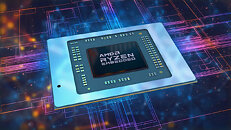AMD today announced the Ryzen Embedded R2000 Series, second-generation mid-range system-on-chip (SoC) processors optimized for a wide range of industrial and robotics systems, machine vision, IoT and thin-client equipment. Ryzen Embedded R2000 Series doubles the core count and delivers a significant performance uplift compared to the prior generation, with the new R2514 model exhibiting up to 81 percent higher CPU and graphics performance than the comparable R1000 series processor. Performance-per-watt efficiency is also optimized using "Zen+" core architecture with AMD Radeon graphics for rich and versatile multimedia capabilities. Ryzen Embedded R2000 processors can power up to four independent displays in brilliant 4K resolution.
Embedded R2000 Series processors are scalable up to four "Zen+" CPU cores with eight threads, 2 MB of L2 cache and 4 MB of shared L3 cache. This gives embedded system designers great flexibility to scale performance and power efficiencies with a single processing platform. With support for up to 3200 MT/s DDR4 dual-channel memory and expanded I/O connectivity, the Ryzen Embedded R2000 Series processors deliver 33 percent higher memory bandwidth and up to 2X greater I/O connectivity compared to R1000 series processors.

"For industrial applications like robotics and machine vision as well as thin clients and mini-PCs, the Ryzen Embedded R2000 Series raises the bar on performance and functionality," said Rajneesh Gaur, corporate vice president and general manager, Adaptive & Embedded Computing Group at AMD. "The Embedded R2000 Series provides system designers with more performance, optimized power and better graphics, all with a seamless upgrade path."
Product Specifications

Additional Key Features and Benefits
View at TechPowerUp Main Site | Source
Embedded R2000 Series processors are scalable up to four "Zen+" CPU cores with eight threads, 2 MB of L2 cache and 4 MB of shared L3 cache. This gives embedded system designers great flexibility to scale performance and power efficiencies with a single processing platform. With support for up to 3200 MT/s DDR4 dual-channel memory and expanded I/O connectivity, the Ryzen Embedded R2000 Series processors deliver 33 percent higher memory bandwidth and up to 2X greater I/O connectivity compared to R1000 series processors.

"For industrial applications like robotics and machine vision as well as thin clients and mini-PCs, the Ryzen Embedded R2000 Series raises the bar on performance and functionality," said Rajneesh Gaur, corporate vice president and general manager, Adaptive & Embedded Computing Group at AMD. "The Embedded R2000 Series provides system designers with more performance, optimized power and better graphics, all with a seamless upgrade path."
Product Specifications

Additional Key Features and Benefits
- Power up to four independent displays in crisp 4K resolution leveraging DisplayPort 1.4, HDMI 2.0b, or eDP 1.3 interfaces
- Broad set of high-speed peripherals and interfaces with up to 16 lanes of PCIe Gen3, 2x SATA 3.0 and 6 USB ports (USB 3.2 Gen2 and 2.0)
- OS support includes Microsoft Windows 11/10, and Linux Ubuntu LTS
- Enterprise class security features supported by the AMD Secure Processor to help protect sensitive data and validate code before it is executed and AMD Memory Guard for real-time DRAM memory encryption
- Planned product availability extends up to 10 years, providing customers with a long-lifecycle support roadmap
View at TechPowerUp Main Site | Source



